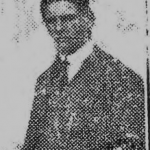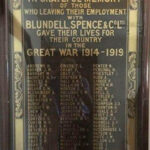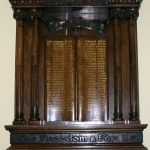BORN HULL 1895. SON OF FRED COLLEY (1865-1947) & ROSE ELLEN SHEARSMITH (1868-1917), OF 46 WATERLOO STREET, HULL, AND 21 PRINCES AVENUE, HULL (CWGC ADDRESS). ONE OF NINE CHILDREN. THE FAMILY RAN A POULTRY, & FRUIT SHOP.
HE WAS EMPLOYED BY MESSRS. BLUNDEL & SPENCE LTD, BEVERLEY ROAD. HE WAS AN OUTSTANDING AMATEUR RUGBY LEAGUE PLAYER, WHO PLAYED FOR THE WORKS TEAM, WITH THE EQUALLY PROMISING, JAMES ‘JERRY’ WATSON. ‘WILF’ WAS DESCRIBED AS A “FORWARD OF ROBUST STYLE”. THEIR LAST MATCH PLAYED FOR BLUNDELL’S, WAS AGAINST SISSONS, IN THE 1913 ANNUAL CHARITY CUP. BOTH PLAYED BRILLIANTLY (JERRY WATSON SCORED TWO TRIES).
“WILF” COLLEY ENLISTED IN HULL AND SERVED WITH 1/4TH EAST YORKSHIRE REGIMENT. HE WAS KILLED IN ACTION AT YPRES, ON 3RD MAY 1915, AGED 21. HE IS COMMEMORATED ON THE MENIN GATE MEMORIAL, YPRES. HE WAS UNMARRIED. HIS ARMY EFFECTS WERE RETURNED TO HIS FATHER. HIS DEATH WAS REPORTED IN THE HULL DAILY MAIL, ON 03/05/1917 AND ON THE 22/10/1917.
WILF’S DEATH CAST A “DARK GLOOM” AT BLUNDEL’S AND WAS KEENLY FELT WITHIN LOCAL RUGBY FOOTBALL CIRCLES. (HULL DAILY MAIL 14/05/1915). *
“WILF’S” STORY AND PHOTOGRAPH WERE PUBLISHED IN THE HULL TIMES, ON 15TH MAY 1915. WILF’S DEATH AND PHOTOGRAPH WERE ALSO PRINTED IN THE HULL DAILY MAIL ON THE 14TH MAY 1915. * A LETTER FROM PRIVATE, JOE TAYLOR, TO HIS WIFE WAS PRINTED IN THE HULL TIMES (15/05/1915) TELLING HER TO INFORM HIS COUSIN THAT HE HAD BEEN KILLED.
HIS BROTHER, LANCE CORPORAL, STANLEY COLLEY, MACHINE GUN CORPS, WAS KILLED IN ACTION TWO YEARS LATER, ON 15/10/1917, AGED 20. ANOTHER BROTHER, ALBERT COLLEY, A FISHERMAN, DIED AT HULL, ON 30/04/1917, AGED 27. THEIR MOTHER DIED 19/03/1917, AGED 48 YEARS.
BROTHERS, WILF AND STANLEY COLLEY, ARE BOTH LISTED ON HULL’S, CLOWES CHAPEL, JARRETT STREET MEMORIAL & CLIFTON STREET SCHOOL ROLL OF HONOUR.
WILF’S GREAT TEAM MATE, JERRY WATSON SERVED WITH THE 1ST EAST YORKSHIRE REGIMENT AND WAS KILLED ON 18/10/1914, AGED 18.
1/4th Battalion – The Northumbrian Division became part of Central Force in Home Defence, tasked with manning the Tyne Defences, so after some days digging trenches in South Holderness 4th East Yorkshires moved to Hummersknott Park, near Darlington to join the York & Durham Brigade. In mid-October it moved again, to Newcastle upon Tyne. It was not until November that the Home Service and unfit men were separated into the 2/4th Battalion, and that battalion’s staff returned to Londesborough Barracks to begin training the recruits
While working on the Tyne Defences, the Northumbrian Division was also undergoing battle training. In April 1915 it was warned for overseas service with the British Expeditionary Force (BEF), and on 16 April its units began to entrain for the embarkation ports. 1/4th East Yorkshires landed at Boulogne the following day.
Second Battle of Ypres – The Northumbrian Division completed its concentration in the Steenvoorde area on 23 April, and went into action the very next day during the Second Battle of Ypres. The York and Durham Brigade went by motor bus to Poperinghe, where they debussed and marched to camp at Vlamertinghe. They were turned out at 01.00 on 24 April and marched to take over trenches astride the Yser Canal, where they came under shellfire at first light, 1/4th East Yorkshires losing their first casualties of the war. During the morning the battalion was shifted again, to a position near Potijze Château, where they dug in again. Meanwhile, the Canadian Division were coming under heavy pressure (the beginning of the Battle of St Julien). Finally, at 15.00 the tired battalion was ordered out to support a counter-attack by the Canadians and the 1/4th Green Howards of the York & Durham Bde (the Canadians were not informed of these two battalions’ involvement). The battalion moved up into a small wood and waited alongside the Canadian artillery under shellfire while the attack developed. Shortly after 17.00 the battalion was ordered to attack towards St Julien and advanced in ‘artillery formation’, with two platoons of D Company in front, led by Lt-Col Shaw. On reaching Bridge House the battalion swung north towards St Julien; it now came under heavy rifle and machine gun fire and was swept by Shrapnel shells and heavy howitzer shells. Eye-witnesses described the tired and hungry battalion behaving ‘as if they were doing an attack practice in peace’. At 950 yards (870 m) and again at 500 yards (460 m) the men opened rifle fire on the enemy, with little apparent effect. Coming upon a road the battalion could advance no further against the hostile fire, and took cover. Lieutenant-Colonel Shaw had been killed by a rifle bullet during the advance, and the CO of the Green Howards took over both battalions. The East Yorkshires were ordered to stay where they were until nightfall; they saw no sign of the Canadians who were supposed to be in St Julien, but their rifle fire combined with the Canadian artillery broke up a German attack from the village, and neither side held it at the end of the day. 1/4th East Yorkshires was permitted to withdraw after dark; in its first action the battalion had lost three officers and 12 other ranks killed, 66 wounded and 17 missing, of whom 10 were known to be wounded. Next morning the 1/4th Bn took over some support trenches in the ‘GHQ Line’, where it was shelled all day, before being withdrawn during the night to march through the ruins of Ypres to a rest camp west of the town. Two days later they went back into the line, supporting 4th Division in a succession of poor trenches under intermittent shellfire. The Battle of St Julien continued for several more days, with the Ypres Salient becoming an increasingly dangerous position. On 2 and 3 May the Northumbrian Division was involved in a general withdrawal to a more defensible line. On 4 May the battalion settled into bivouacs near Steenvoorde, having suffered 33 killed and 58 wounded since 1 May.


